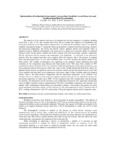Please use this identifier to cite or link to this item:
http://www.alice.cnptia.embrapa.br/alice/handle/doc/894535| Title: | Optimization of technological parameters to produce breakfast cereal from rice and common bean flour by extrusion. |
| Authors: | CARVALHO, A. V.  RIOS, A. de O.   BASSINELLO, P. Z.   |
| Affiliation: | ANA VANIA CARVALHO, CPATU; ALESSANDRO DE O. RIOS, UNIVERSIDADE FEDERAL DO RIO GRANDE DO SUL; PRISCILA ZACZUK BASSINELLO, CNPAF. |
| Date Issued: | 2011 |
| Citation: | In: INTERNATIONAL CONGRESS ON ENGINEERING AND FOOD, 11., 2011, Athens. Food process engineering in a changing world: proceedings. Athens: International Association for Engineering and Food, 2011. |
| Description: | The objective of the present work was to investigate the relevant parameters to elaborate breakfast cereal from a mix of rice and common bean flour and to evaluate the influence of formulations and processing conditions on the final product characteristics. To elaborate the breakfast cereal it was applied a complete experimental design 23, testing the following parameters: common bean flour percentage, moisture and processing temperature, and having the protein content, apparent density and expansion index as statistical answers. Different formulations were processed in a single-screw extrusion. Based on statistical analyses results, for the protein variable, the factors common bean flour percentage, moisture, temperature and the interaction between moisture and temperature were significant. As expected, it was observed a positive effect for common bean flour and a negative effect for moisture, that is, the increase of common bean flour percentage from 13 to 47% and of moisture from 10 to 20%, increased the protein content of the final product. The variable of temperature was significant in the quadratic model, indicating that small variations on the temperature may influence the final protein level. With bean flour contents of 30% considerable contents of protein (13%) were obtained, without prejudicing the technological parameters, once these parameters showed better answers with lower values to this variable. Besides the bean flour content, the apparent density showed as significant answers the moisture content and the interactions between bean flour versus moisture and bean flour versus temperature, since lower values of these variables reduce the apparent density value of the final product. Temperature and the interaction temperature versus moisture were relevant, however to obtain a cereal with lower apparent density (0.20 g/cm³) one should not increase the processing temperature to values up to 100ºC. To the expansion index, the common bean flour percentage, the moisture, the temperature and the moisture versus temperature interaction were significant, having been observed higher expansion indexes (approximately 9.0) when intermediate temperature and moisture were applied. Since technological characteristics are primordial to obtain a final product with quality, the better results indicated a bean flour content of 30%, moisture of 14% and temperature at the 3rd extrusion zone of 80oC, resulting a final product with 13% crude protein, 0.20 g/cm³ apparent density and 9.5 expansion index. |
| Thesagro: | Arroz Feijão Farinha Extrusão |
| NAL Thesaurus: | Thermoplastics Experimental design Breakfast cereals Extrusion |
| Type of Material: | Artigo em anais e proceedings |
| Access: | openAccess |
| Appears in Collections: | Artigo em anais de congresso (CNPAF)  |
Files in This Item:
| File | Description | Size | Format | |
|---|---|---|---|---|
| MCF481.pdf | 279.65 kB | Adobe PDF |  View/Open |









